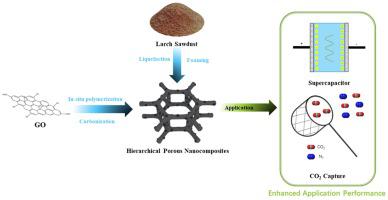Journal of CO2 Utilization ( IF 7.2 ) Pub Date : 2021-08-07 , DOI: 10.1016/j.jcou.2021.101666 Yuhang Zhang 1, 2 , Jiaming Sun 1, 2 , Jia Tan 1, 2 , ChunHui Ma 1, 2 , Sha Luo 1, 2 , Wei Li 1, 2 , Shouxin Liu 1, 2

|
The development of biomass-based carbon foams with hierarchical pore structures could lead to practical applications in CO2 capture systems and supercapacitors. However, these materials typically exhibit inferior adsorption and electrochemical characteristics because their pore structures are damaged during processing. The present work synthesized hierarchical porous graphene oxide (GO)/biomass-based carbon foam (GCF) nanocomposites from liquefied larch sawdust using in situ polymerization, foaming and carbonization steps. The GO enhanced the thermal stability of the foam while preventing collapse of the pore structure. The resulting GCF nanocomposites possessed hierarchical pore structures with greater ultramicroporosity than the original CF, especially with regard to the number of pores with sizes from 0.50 to 0.80 nm. Micropores with diameters less than 0.60 and 0.80 nm were found to be the primary factors determining CO2 adsorption at 0.15 and 1 bar, respectively, such that the GCF-0.2 (the addition of 0.2 wt%) exhibited the highest CO2 capacity of 4.99 mmol g−1 at 0 °C and 1 bar. These materials also showed CO2/N2 selectivity values up to 100.21, moderate heats of adsorption between 10.27 and 18.77 kJ mol−1 and good stabilities. The GCF-0.2 displayed a specific capacitance of 173.20 F g−1 at a current density of 1A g−1 in a 6 M KOH electrolyte and demostrated superior capacitance retention that could lead to applications in supercapacitors.
中文翻译:

来自落叶松的分层多孔氧化石墨烯/碳泡沫纳米复合材料可增强二氧化碳捕获和储能性能
具有分级孔结构的生物质基碳泡沫的开发可导致在 CO 2捕获系统和超级电容器中的实际应用。然而,这些材料通常表现出较差的吸附和电化学特性,因为它们的孔结构在加工过程中被破坏。目前的工作是从液化的落叶松木屑中原位合成分层多孔氧化石墨烯(GO)/生物质碳泡沫(GCF)纳米复合材料聚合、发泡和碳化步骤。GO增强了泡沫的热稳定性,同时防止了孔结构的坍塌。所得的 GCF 纳米复合材料具有分层孔隙结构,其超微孔隙率比原始 CF 更大,尤其是在尺寸为 0.50 至 0.80 nm 的孔隙数量方面。发现直径小于 0.60 和 0.80 nm 的微孔分别是决定在 0.15 和 1 bar 下CO 2吸附的主要因素,因此 GCF-0.2(添加 0.2 wt%)表现出最高的 CO 2容量为 4.99 mmol g -1在 0 °C 和 1 bar。这些材料还显示出 CO 2 /N 2选择性值高达 100.21,中等吸附热介于 10.27 和 18.77 kJ mol -1 之间,并且稳定性良好。GCF-0.2在 1A g -1的电流密度下在 6 M KOH 电解质中显示出 173.20 F g -1的比电容,并展示了优异的电容保持率,可用于超级电容器。











































 京公网安备 11010802027423号
京公网安备 11010802027423号